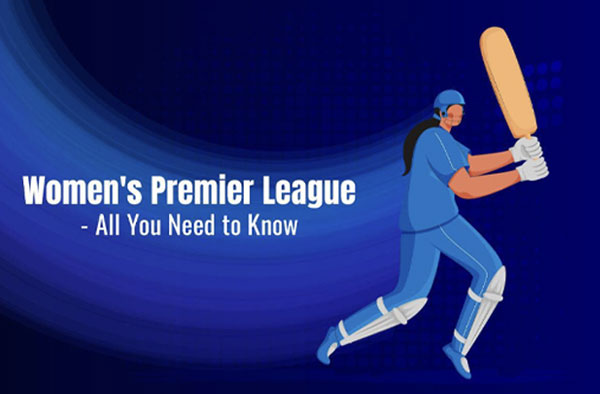In February 2022, BCCI President Sourav Ganguly shared the news that the BCCI was considering a women’s version of the IPL in February 2022. By August of the same year, the plans had reached an advanced stage, and in October 2022, the BCCI announced that it would be a five-team tournament that would taking place in March 2023.

The WPL is a T20 franchise-based league similar to the IPL and is owned and operated by the BCCI.
This league was tagged informally as the Women’s Indian Premier League. In January 2023, the BCCI officially gave it the name Women’s Premier League.
Following the christening on 28th January 2023, the BCCI invited bids for the league’s title sponsorship rights. The Tata Group won the bid for an undisclosed amount, and it runs until 2027.
Fifteen years after the men’s IPL League was announced, women’s cricket is now in the spotlight as the long-awaited Women’s Premier League takes center stage.
Melinda Farrell of ESPN, while speaking to Al Jazeera, said that the WPL is perhaps going to be the most transformative competition ever seen in women’s cricket.
WPL Structure:
The league structure for the WPL is similar to that of the IPL – which is the men’s league. Depending on the endeavor’s success, the BCCI plans to allow more franchises over the current five. Allowing more franchises to take part would mean increased fixtures and more exciting times ahead for the league’s fans.
Participation in the WPL will give women cricketers the opportunity to play the sport they have an affinity for while also showcasing their talent in what is a lucrative league with the spotlight firmly affixed on it.
The creation of WPL fantasy cricket leagues similar to IPL will further push it into the public eye.
The Inaugural Edition:
The first edition of the WPL got underway on 4th March at Navi Mumbai’s DY Patil Stadium and concluded on 26th March – a run time of three weeks.
The female cricketers, featuring a mix of Indian and international players, made most of the benefits offered by the WPL by bagging lucrative pay packets and from the league’s publicity during its first-ever edition.
The five teams in the league faced each other in a double round-robin format, with the three teams finishing on the top of the points table entering the competition’s playoff stage.
The tournament is in its concluding stage, where Delhi Capitals will face off against the winner of the eliminator between Mumbai Indians and UP Warriorz.
The five franchises of the competition are:
- Delhi Capitals
- Mumbai Indians
- Royal Challenger Bangalore
- Gujarat Giants
- UP Warriorz
Business Model:
The BCCI stated that under the revenue-sharing agreement reached with the franchise owners, eighty percent of the profits generated from the competition would be distributed among the franchise owners during the first five years.
During the next five, 60% of the profits will be shared, and from seasons 11 to 15, the figure will be 50%.
Additionally, 80% of the revenue generated from the central licensing rights will also be shared with the franchises. Franchises will also have a stake in the income got from ticket sales and advertising. Apart from this, they will also benefit from sales of official team merchandise.
This is a significant sharing of the pie as it has a hand in offsetting a substantial part of the franchise’s operational costs.
To continue attracting some of the best talents to the WPL, the administrators should ensure equitable sharing of the revenue for the players in the WPL, without whom there would be no contest to begin with.
The BCCI would do well to emulate the revenue-sharing arrangements of the IPL or other sports, such as football’s English Premier League.
Future Prospects Of The WPL:
If the viewer ratings of the first-ever WPL competition are anything to go by, the long-term prospects of the league are highly viable.
When the WPL is viewed through the prism of the confidence-boosting metrics of broadcasting revenue, the optics of high attendance, fan engagement, and quality of cricket on display, the future of the Women’s Premier League paints a rosy picture.
Even though the INR 12 crore auction purse held by each of the five franchises to the 5-year Rs 951 crore broadcasting deal bagged by Viacom 18 has been modest by IPL standards, it is of significant value when viewed in the context of the women’s game and where it stands today.
It is also noteworthy that the value of the TV rights purchased by Viacom was more than what was paid for the inaugural edition of the IPL.
Cricket pundits, sponsors, and broadcasters alike will be closely evaluating the progress of the Women’s Premier League to see if it is able to translate the initial love it has received into ticket sales, to stay financially viable. If the WPL is successful, then the tournament could be an example for other countries to start similar leagues where cricket is popular.
Conclusion:
Courtesy of the publicity and the steps taken by the BCCI to promote the WPL, women’s cricket has received a shot in the arm, and this can only bode well for the future of the women’s league. The league has been long overdue, and now that it has been launched and with the competition well underway, there is justifiable enthusiasm surrounding it.
The amount of funds that flowed into the league and the tournament before even any bowler ran up to the mark is a bonus and a formidable statement to those airing their thoughts on the financial viability of a women’s T20 league.

Loves all things female cricket
